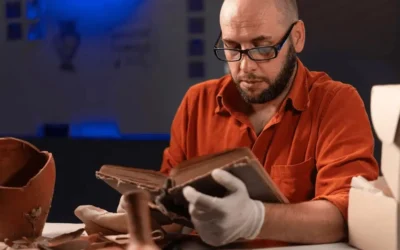Establishing Archival Identity
Margot Note
In archiving, establishing a distinct identity includes both preserving historical records and defining the value archivists bring to their organizations.
The essential aspects of archives shape their brand through the four Vs: vision, voice, visibility, and vigilance.
This process involves organizing a collection of documents, photographs, and other materials to convey a cohesive narrative that reflects the organization’s purpose and mission. The vision encapsulates the overarching goals guiding the archival efforts, outlining the desired impact on future generations. Voice refers to how information is presented, ensuring clarity and resonance with the intended audience. Visibility emphasizes promoting archival content to enhance public awareness and engagement. Lastly, vigilance involves maintaining a watchful eye on the integrity and accessibility of the archives, ensuring their relevance and significance over time. By attending to the four Vs, archivists contribute not only to the preservation of historical records but also to the cultivation of a lasting, impactful institutional identity.
Vision
Archivists are the custodians of history, and to establish a robust brand, they must have a clear vision of their role within the organization. This vision goes beyond storing documents; it involves understanding the broader impact their work can have. Archivists set the foundation for their brand identity by articulating their core mission. This vision is a guiding light, influencing the archival’s decisions, initiatives, and collaborations.
Voice
A strong voice characterizes a distinctive brand. Archivists need to communicate their expertise and emphasize the tangible benefits that colleagues derive from their services. The narrative should focus on how archival resources contribute to informed decision-making, problem resolution, and organizational success. This articulation of value becomes the cornerstone of a resonant brand voice.
Visibility
Public relations (PR) is a potent tool for shaping perception. Archivists can amplify their impact by utilizing PR strategies. Success stories become crucial in this context—stories that showcase how archival resources are pivotal in informing decisions, overcoming challenges, and contributing to the organization’s success. Archivists can create a ripple effect through various communication channels, spreading awareness among colleagues.
Vigilance
Being vigilant in seeking PR possibilities within program administration is a strategic move for archivists. Doing so involves adjusting priorities to emphasize public outreach and creating positive press whenever opportunities arise. As archivists analyze how a brand’s messaging aligns with perceptions, messaging and perception strategies come into play. Archivists can adapt them to understand their brand positioning and bridge communication and user perception gaps.
Messaging and Perception
In departments with strong messaging and perception, upholding and aligning messaging with established high standards is challenging. Consistent communication is pivotal in maintaining positive perception, requiring ongoing efforts to enhance messaging strategies and reinforce the department’s value.
In departments with strong archival messaging but a weak perception by colleagues, the focus is on communicating value to foster positive public perception. Tailored messaging emphasizing strengths bridges the gap between the message and actual perception, showcasing contributions and capabilities.
The goal for departments with weak messaging but a strong perception is to bridge the gap between actual value and public understanding. Crafting accurate messaging reflecting strengths is crucial, demanding a strategic approach to educate colleagues about the department’s true potential.
Understanding the gaps between communication and perception is critical to enhancing brand impact. Archivists should work towards aligning their messaging with the actual value they provide. This might involve refining communication strategies, emphasizing certain aspects of their work, or seeking opportunities to showcase success stories.
A Resilient Archival Brand
Archivists are crucial in preserving history and shaping their brand within the organizational landscape. Archivists can establish a resilient identity by focusing on the four Vs: vision, voice, visibility, and vigilance. Integrating messaging and perception further empowers archivists to navigate the complex terrain of branding, ensuring that their contributions are recognized and celebrated within and beyond their organizations. As archivists continue to evolve in the digital age, a strong brand becomes a beacon, guiding their efforts toward a future where preserving the past aligns with the needs of the present.
1 Adapted from Christie Kaaland, “Creating a Districtwide Advocacy Plan, Part 1: Vision and Voice,” School Library Monthly 24, no 3, (2011) and Christie Kaaland, “Creating a Districtwide Advocacy Plan, Part 2: Visibility and Vigilance,” School Library Monthly 24, no. 4, (2012).
Margot Note
To learn more, please join us for a free webinar, Archivists: Elevating through Branding Wednesday, July 10, 2024 at 11 a.m. Pacific, 2 p.m. Eastern. (Can’t make it? Register anyway and we will send you a link to the recording and slides afterwards). Register now.
Never miss another post. Subscribe today!
Similar Posts
Texas Archive of the Moving Image: Interview with the Digital Archivist
I recently interviewed Grace Muñoz about her work at the Texas Archive of the Moving Image. Her work on improving the discoverability of the multimedia collection is fascinating.
How to Conduct Comprehensive Archival Surveys
Conducting a comprehensive archival survey is critical to successfully managing archival collections.
Remembering History, Moving Forward Together, with ArchivEra
The Catholic Diocese of Arlington’s Director of Archives selected ArchivEra to manage their collections of historical and cultural significance, and strike a balance between security and access.
Unveiling Archival Impact
The transformative power of storytelling depends upon the strategic choices that top archival performers make and the shift from being record-keepers to change agents.





Leave a Comment
Comments are reviewed and must adhere to our comments policy.
0 Comments